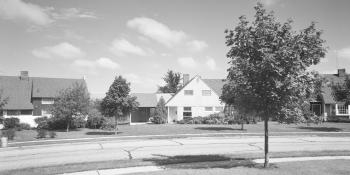
The Fair Housing Act
On the landmark law’s 50th anniversary, Richard Rothstein, a leading expert on U.S. housing policy and author of The Color of Law, explained the need for the Fair Housing Act, its context and the consequences of barriers to equal and affordable housing.
Rothstein is a senior fellow at the Chief Justice Earl Warren Institute on Law and Social Policy at the University of California, Berkeley School of Law.
1958 photo of Levittown residences from Library of Congress, Prints & Photographs Division, Gottscho-Schleisner Collection [LC-G613-72793 (b&w film neg.)]
Q: Paint a picture of the overall availability and affordability of housing prior to the 1968 Fair Housing Act.
A: The Federal Housing Administration, beginning in the 1930s and continuing into the 1960s, recruited a large cadre of mass production builders to create single-family home subdivisions across the country. These were for middle-class and working-class families and, in particular, for returning veterans after World War II. The best example is Levittown, east of New York City.
In Levittown, builder William Levitt could never have assembled the capital to construct the 17,000 homes planned for the development because he had no buyers. The only way he was able to take on that project was by applying for a guaranteed loan from the Federal Housing Administration to buy the land and build the subdivision.
However, an explicit condition that the FHA placed on granting approval was that no home should be sold to African-Americans. The FHA even placed a requirement on builders like Levitt that every home have a clause in the deed prohibiting resale or rental to African-Americans.
The FHA manual given to appraisers who evaluated builders’ applications stated that the subdivision could not be approved if it was not for members of the same racial class. Proposals were even denied for subdivisions close to African-American neighborhoods because they ran the risk of what the manual called “infiltration of incompatible racial elements.”
White working-class families living in public housing could receive subsidies from the FHA to move out of central cities into these single-family home developments in the suburbs. The subsidy was so powerful that a white family who lived in public housing could move into a FHA sponsored single-family home and pay less in their monthly housing charges than they would for rent in public housing. This subdivision model went nationwide.
But everywhere this was done, African- Americans were prohibited from participating.
Q: What has been the long-term effect of that segregation?
A: Looking at our example, homes in Levittown sold for $9,000 in the mid-20th century. Today, that translates to about $100,000. Almost any working-class family — black or white — can afford to buy a house for $100,000 (twice the median national income) with a FHA mortgage today. Except now those homes in developments like Levittown in New York or Lakewood in California sell not for $100,000, but for $300,000 to $500,000. They are unaffordable to working-class families from any race. The white families who gained access to those homes gained $200,000, $300,000, $400,000, or more in wealth over the last few generations.
Most Americans don’t have any wealth other than the equity they hold in their homes. With the FHA’s policy to subsidize homeownership for white families only, African-Americans were left behind.
White families who participated in this program were now financially equipped to send their children to college, to be able to handle medical emergencies, and to manage unemployment. Further, white families in the program often bequeathed their wealth to children who could then spend it on their own homes, education and children’s wellbeing. It created generational wealth.
Today, nationwide, African-American incomes are about 60 percent of white incomes. Yet African-American wealth is about 10 percent of white wealth. And that enormous disparity is entirely attributable to unconstitutional federal housing policy that was perpetuated in the mid-20th century.
Q: What is the impact of barriers to affordable housing on our society, including on people who don’t face them personally?
A: The issue of inclusionary and affordable housing affects everyone; there is no one it does not affect. The most major social problems this society faces stem from residential segregation.
Violence in places like Baltimore, Maryland; Ferguson, Missouri; and other cities over the last few years is a direct consequence of the concentration of low-income families in communities where there is no access to jobs and no hope for young men. Our schools suffer from an enormous achievement gap that is due, in large part, to the fact that children are in segregated schools.
The growing inequality in this country is at least partly attributable to racial segregation. Economists have found that a low-income family whose child grows up in a low-income neighborhood is much less likely to attain middle-class status as an adult compared to a child from a family with the same income who grows up in a less segregated neighborhood. Racial segregation blocks upward social mobility.
Finally, it pollutes our politics. We would not have this kind of racial polarization in our country if it were not for the fact that we have residential polarization.
For all these reasons, it is essential that we as Americans do something about this.


